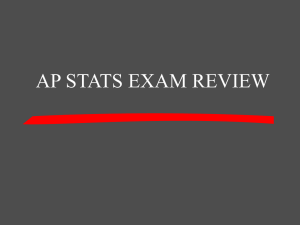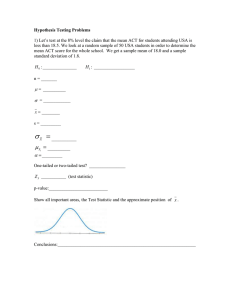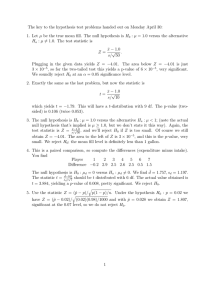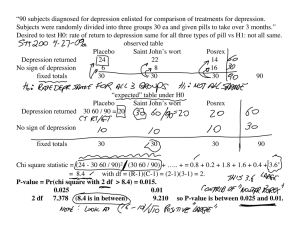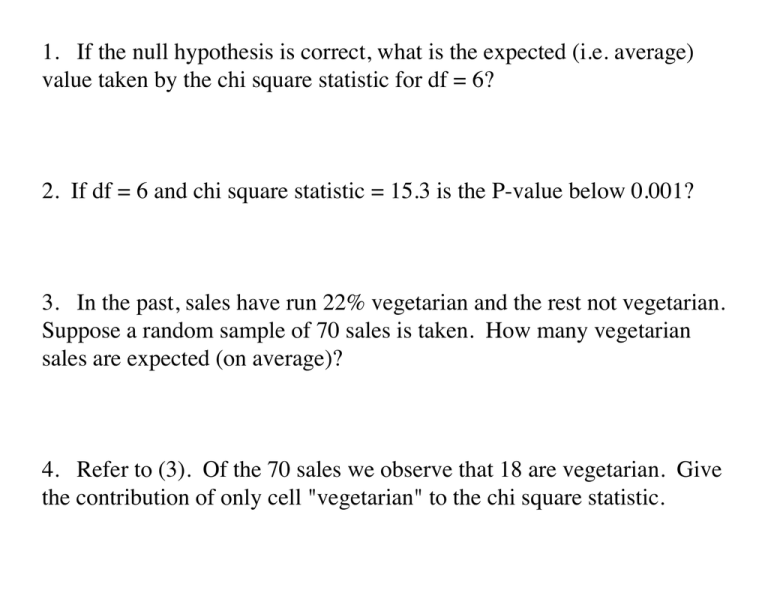
1. If the null hypothesis is correct, what is the expected (i.e. average)
value taken by the chi square statistic for df = 6?
2. If df = 6 and chi square statistic = 15.3 is the P-value below 0.001?
3. In the past, sales have run 22% vegetarian and the rest not vegetarian.
Suppose a random sample of 70 sales is taken. How many vegetarian
sales are expected (on average)?
4. Refer to (3). Of the 70 sales we observe that 18 are vegetarian. Give
the contribution of only cell "vegetarian" to the chi square statistic.
5. If the null hypothesis is correct, what is the approximate distribution
of any one cell's contribution to the chi square statistic?
6. Suppose the null hypothesis is correct. If we are poised to reject the
null hypothesis if P-value < 0.03, what is the probability that we will
reject the null hypothesis (false rejection)?
7. A random sample of 400 patients is sorted into the table below.
Determine df for a chi square test of the independence of sex and
income.
sex \ income
L
M
H
male
20
120
10
female
30
80
40
8. Refer to (7). Give the marginal total for "male," marginal total for
"L," and grand total.
Test of independence.
sex \ income
L
male
female
M
20
30
H
120
80
10
40
9. Refer to (7). Give the expected count for cell "male L."
10. Refer to (7). Give the contribution of only cell "male L" to the
chi square statistic.
11.
If the following probabilities apply to a random selection of a
patient, is sex independent of income? Be sure to say why your
answer is correct.
sex \ income
L
M
H
male
0.1
0.08 0.02
female
0.4
0.32
0.08
12. See (11). Suppose we randomly sample 100 individuals finding
sex \ income
L
M
H
male
4
16
10
female
10
40
25
Determine the expected counts under independence hypothesis.
Binomial: p = probability of “success,” q = 1-p.
13-16. A random sample of 400 emergency responders finds 50 who
require additional training.
13. Estimate p by pHAT.
14. Estimate the margin of error for the estimate pHAT.
15. Determine the 95% CI for p.
16. If 100 experimenters each forms a 95% CI for p, around how
many of these CI are expected to cover p?
Binomial: p = probability of “success,” q = 1-p.
17-21. IF more than 20% of emergency responders require additional training THEN
additional money will have to be found.
17. Suggest H0 and H1 for a test to address the issue.
18. A random sample of 200 emergency responders finds 50 who
require the training. Calculate an appropriate test statistic.
19. Determine the P-value. Does it seem that additional money will
be needed?
20. If instead H1: “p is not .2” determine the P-value.
21. From (20) determine the P-value.
22. For a test of H0: p = 0.2 versus H1: “p is not 0.2” we may employ chi square goodness of fit.
Give the table of exp and obs counts for such a test if a sample of 200 finds 50 (as above).
require training
do not require training
exp
obs
std score
23. Refer to (22). Determine the chi square statistic for the test.
24. Refer to (22). Determine the P-value.
25. Meta Analysis. Each of two experimenters independently finds
chi sq = 9.54
df = 6 Test H0: both null hyp are correct.
chi sq = 14.33 df = 9


